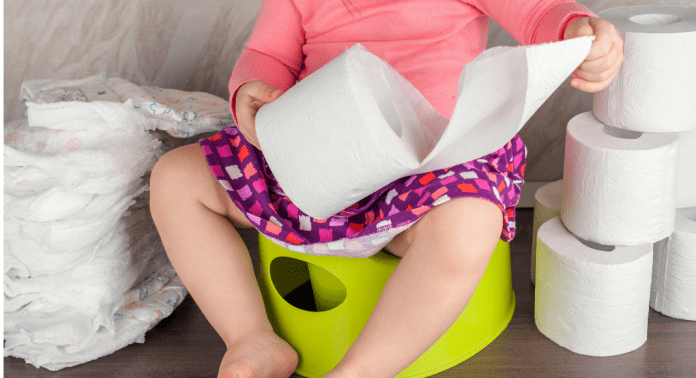One way to describe constipation is frustrating! It’s an uncomfortable and sometimes painful experience related to hard, infrequent poops and even feeling stuck. As a parent, you may find yourselves talking about poop more often than you’d like to admit. I’d also bet you don’t typically think about constipation when starting to potty train a toddler, and even more rarely think about it when your children are older. But it is common in kids (and their parents… ahem) and let’s get you ready to help them get unstuck.
What is constipation?
Constipation is when you are unable to poop, have trouble pooping or feel like you haven’t gotten rid of all your stool after trying to poop. Constipation doesn’t always mean full blockage, though it can. In fact, you can be constipated even if your poops aren’t hard or if you are pooping semi-regularly. Constipation is determined by how often the child poops, the amount of poop coming out and the consistency. Constipation can include some or all of these:
- Being unable to poop more than 2 times a week.
- Painful passing of hard stools.
- Passing small, rock poops.
- Feeling like you can’t get rid of all of the poop at one time.
Who can be constipated?
Anyone can get constipated. Kids of all ages can be constipated. It’s more common in toddler or preschool aged children who are learning to potty train and those with certain medical and neurodevelopmental conditions. It also happens often in school-aged children who may hold in their poop.
What causes constipation?
Constipation can be caused my medical conditions (e.g., thyroid conditions, celiac disease, or Hirschsprung’s Disease) but for most kids there is no identifiable medical cause for constipation. This is called functional or idiopathic constipation.
There are things that can contribute to constipation: `
- Change in diet, like from breastmilk to solid foods.
- Limited dietary fiber or fluid intake – although more important for those with very limited diet and fluid intake vs. those with a normal diet.
- During toilet training.
- After an illness or taking certain medications.
- Anxiety or stress from things like big life transitions or pressure at school.
- Poop avoidance, like not wanting to poop at school or outside the home.
- Medical conditions like colon disease, irritable bowel syndrome or neurological disorder.
- Poor or slow motility of the gut.
- Lack of or sufficient toileting habits (e.g., sitting regularly, allowing time in the bathroom).
- Sometimes there are no contributors to constipation and that is OK – we still know how to treat it.
Signs and symptoms of constipation
It can be more challenging when your child is older to know about their bathroom habits. You may have stopped tracking their bowel movements after toddlerhood, so how could you possibly know what’s going on? There are a few signs you can watch for:
- Going to the bathroom less than usual or more than usual (due to needing to stool but not being able to).
- Difficulty or straining to poop.
- Blood in the toilet or on toilet paper.
- History of passing large sized poop that can be difficult to flush.
- Soiling in their underwear.
- Stomach pain or feeling bloated.
- Decreased appetite.
- Nausea or vomiting without being sick.
- Increased frequency of urinary incontinence.
How parents can help prevent or treat constipation
Talk about poop. You might be a parent if you can talk without batting an eye. Talking about poop and healthy poop can help create a safe space for children to also talk about it. When kids are young, you can easily celebrate a poop in the toilet. Gold stars for poop! When kids are older, it’s not always a topic of discussion they want to participate in. You may notice non-judgmentally that your child spent awhile in the bathroom or had some soils in their underwear. Then, you can let them know that these things are not their fault and might be related to constipation. We want to keep shame out of the bathroom!
During potty training. Toilet training is a huge life change for a child. We often see a poop strike during this time, where a child doesn’t want to poop on the toilet or without their diaper. Sometimes they stop pooping all together! This makes poop harder and more difficult to pass, even causing pain. When pooping hurts, kids definitely don’t want to do it! Try to be patient, temper frustration, offer privacy when appropriate and show encouragement. Rewards can be really helpful in potty training and are NOT bribery. We get paid to go to work and do difficult things, so why not offer a reward to our children learning a hard, new skill?
Helping with diet. What a child eats can also contribute to constipation. A diet with low fiber, not enough water and consumption of a large amount of dairy can contribute to constipation. It’s important that parents know that nutrition and fluid is only one PART of the picture and should not be the only intervention families focus on. Rather than counting fiber and fluids obsessively, focus on feeding your child a varied diet that includes fruits and vegetables and enough liquid that their urine is clear. If your child is already meeting these goals and is still constipated, that doesn’t mean something is wrong with them.
Seek Treatment. Laxatives are safe to use in children and many gastrointroenterologists use them to treat constipation in children. Treating constipation can prevent long-term problems like poop accidents or new problems with wetting. Over-the-counter laxatives like MiraLAX can be helpful for relieving constipation in children. Consult with your child’s doctor about which medications might be right for them based on their symptoms, what medicines they can and will take and how long they have been constipated.
Bowel training. Sometimes after longer periods of constipation it can be hard to know when you have to poop. That sensation to go isn’t there anymore or is more like a whisper rather than a roar. Try to have your child sit on the toilet to focus on pooping for at least 5 minutes about 20 to 30 minutes after meals. This may help them to relax and see if they have to go, taking advantage of their body’s natural functioning after meals. Bathroom schedules are actually as important as medicines in bowel training! Offering consistent times for them to sit and try throughout the day may help retrain their brain and recognize the need to stool.
Treatment for constipation
Pooping shouldn’t be a painful or unpleasant experience, but it is for many children. If your child has chronic, or frequent issues with pooping you can talk with your pediatrician about what to do next. They may be able to offer medications or a referral to a gastrointestinal specialist for more help. Help is out there and may require some patience on your part. Often constipation is chronic and requires long-term planning rather than a short-term solution.
This post was written by Christina Low Kapalu, PhD – Child Psychologist at Children’s Mercy Kansas City.
Comprehensive GI Care from Pediatric Experts 
The Division of Pediatric Gastroenterology (GI) at Children’s Mercy Kansas City is one of the largest in the U.S. Nationally recognized for providing excellent care for children with intestinal, liver, esophageal and nutritional disorders, children and teens with GI conditions benefit from our comprehensive, child-centered care. Our experienced GI team collaborates with others and incorporates the latest research to give every child the best possible care experience.

















